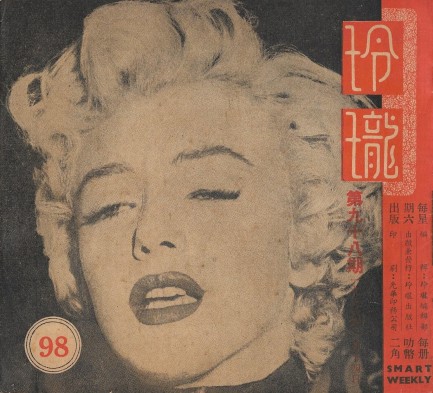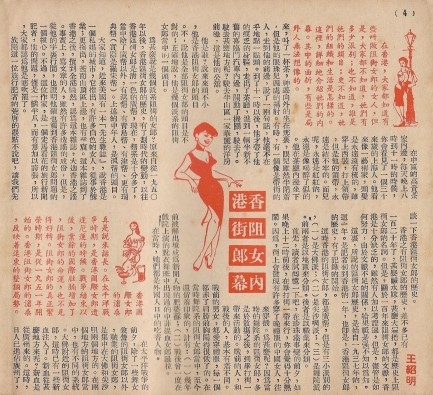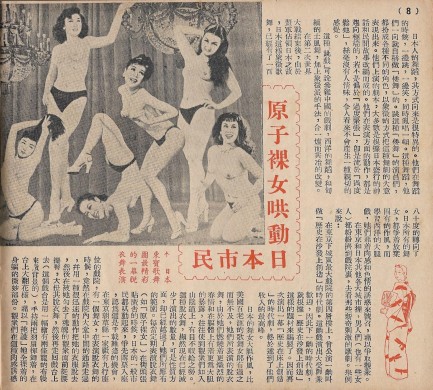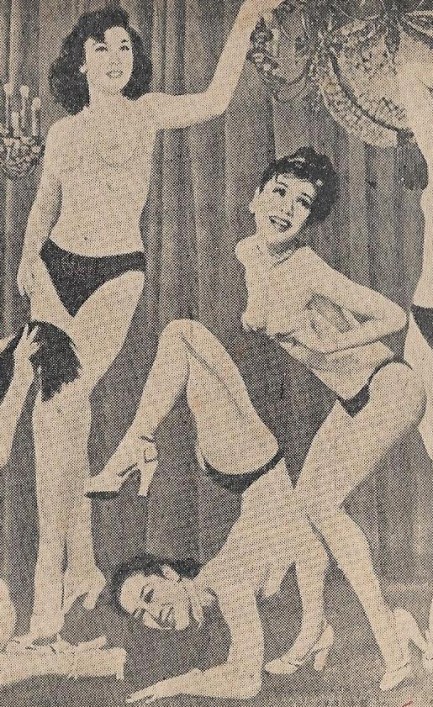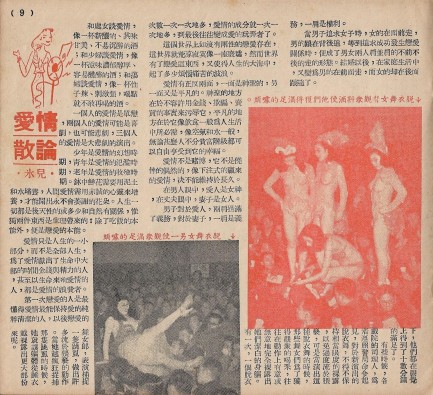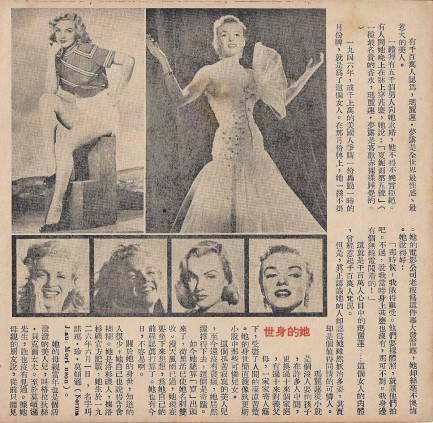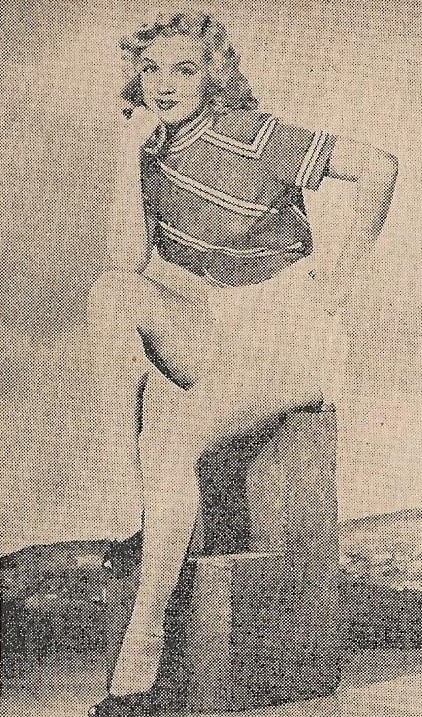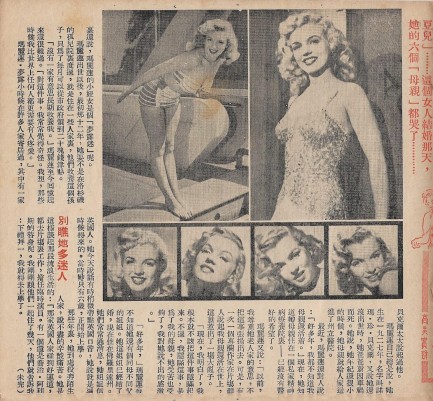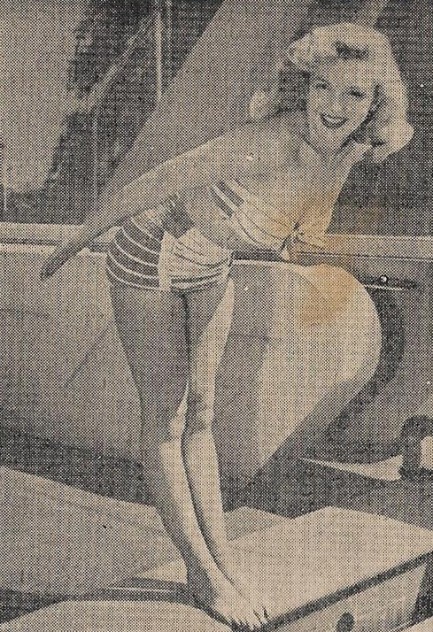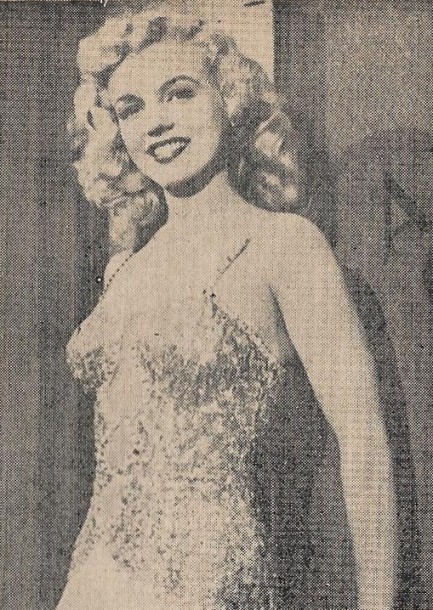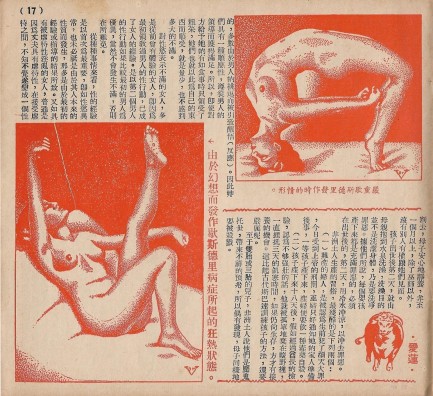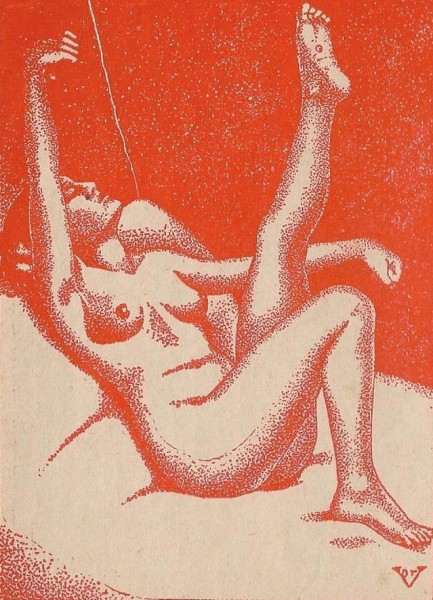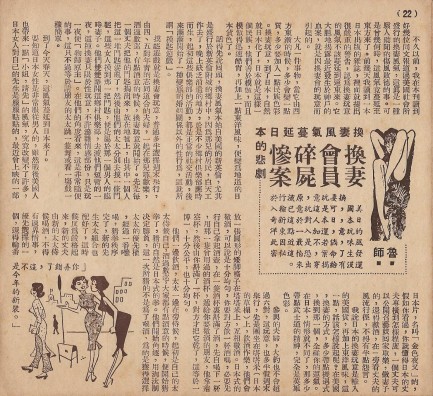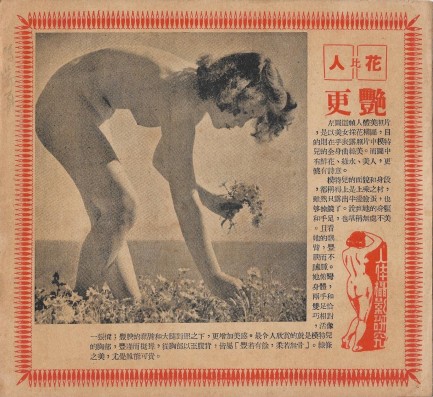 I always appreciate attention from a handsome lifeguard, but I think someone's drowning over there. 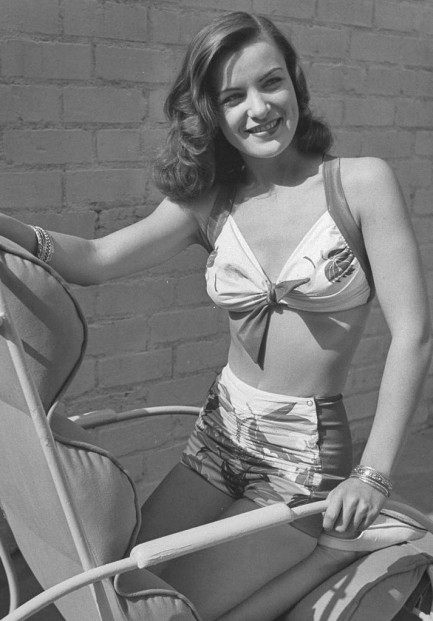
Above, U.S. born actress Ella Raines lounges in her bathing suit in this summery image from 1943 made in Los Angeles at the Town House Hotel. Later she'd take a dip in the pool. Raines appeared in such films as Phantom Lady, Impact, and Brute Force, before transitioning to television in the 1950s. We talked about her 1947 film noir The Web a few years ago and you can read about that here.
 I've come to kidnap you—for another book cover. 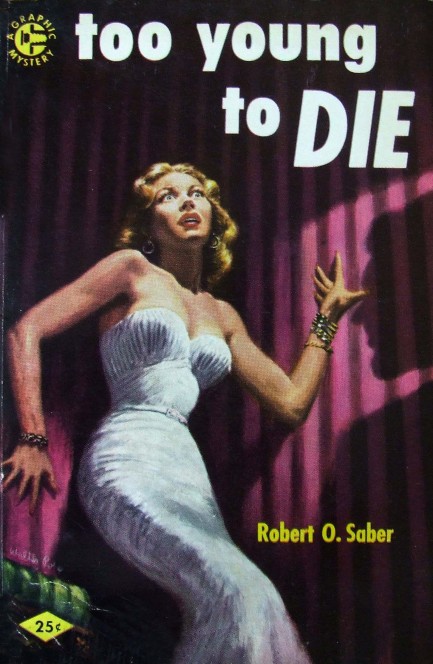 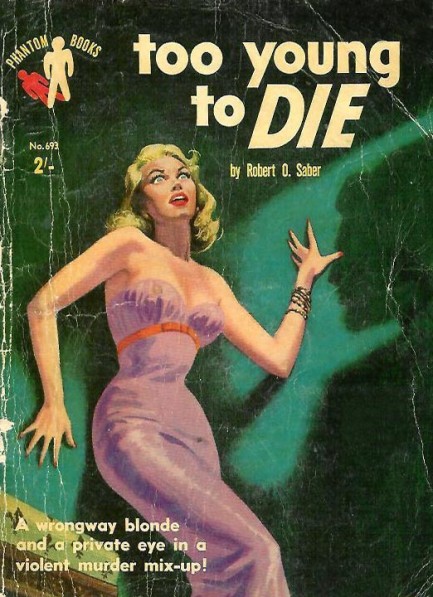
Above you see two covers for Robert O. Saber's thriller Too Young To Die, the first from Graphic Books, and the second from Australian publisher Phantom. The art at top, which we think is brilliant, was painted by Walter Popp, a well known paperback and men's magazine illustrator who we've talked about several times. You can see some of those examples by clicking his keywords at bottom. His cover was copied by an anonymous artist for Phantom's re-issue. So as always we come back to the question: Why were publishers able to copy original art, but not to use it outright? Assume you're Walter Popp and you've already been paid by Graphic for the use of your art. Phantom comes along and asks you to reuse it. It's free money in the sense that you've already done the work, and it's more exposure for your talent. So why not say yes? Since there's no reason in the world to say no we can only assume he was never asked. Looking at it from the other side, if you like Walter Popp's cover work but can't obtain the right to use it, how is it that you can get away with publishing a near exact copy? We posed that question to Bob over at the authoritative website menspulpmags.com, and he said that he thinks copycat covers that were not actual reuses of the original skated under copyright laws, and generally nobody paid much attention to them. Bob also offered these insights: Some of the artists who worked for mid-20th century men's adventure magazines and paperbacks that I've talked to have said they sometimes got paid small reprint fees for reuses of their work, but often did not. In the case of the men's adventure magazines, I know the artists typically only sold first publication rights and the artists who were most business savvy, like Mort Kunstler, made sure to get their originals back from the company or get fees for reuses. But some artists just turned in their illustrations to the art directors and didn't bother to get them back to track whether they were reused. Some magazines that published multiple men's adventure magazines, like those put out by Martin Goodman's Magazine Management company, often reused illustrations in several different issues and sometimes used a magazine illustration on the cover of a paperback published by their paperback subsidiary (Lion Books in the case of Magazine Management), or vice versa. I show an example of a Samson Pollen painting used on a Lion paperback and a Mag Mgt. men's adventure mag in a recent post on my blog here. There are many other examples of men's adventure mag illos being used on both a paperback cover and in a men's adventure magazine. For example, Pyramid published both paperbacks and Man's Magazine and many Pyramid cover paintings showed up as illustrations in Man's. I don't know if artists typically only sold first use rights to paperback publishers or all rights. I suspect it varied with the publisher. I do know many paperback cover paintings were reused both on other paperbacks and in men's adventure mags. I also know that Gil Cohen, who I recently interviewed for my blog, told me he sold only first rights to Pinnacle for the roughly two-hundred Executioner/Mack Bolan paperback cover paintings he did. I'd guess that whether an artist got paid for reuses depended on how honorable the publishers were. Mag Mgt. and Pyramid actually treated their artists pretty well, from what I have been able to glean. However, it seems pretty clear that many low budget men's adventure mags and paperback publishers just ripped artists off by reusing their artwork without paying them. I think that practice was pretty common and there was really no way for artists to keep track of all reuses back then. They would just have to happen to run across them on newsstands. And even then, they might not think it was worth the hassle of trying to do anything about it. Pulp art was basically viewed as "disposable" artwork without a lot of resale value back in the '50s, '60s and '70s. I think most artists were more concerned about getting their next assignment than trying to get smaller reprint fees for past work.
So there you have it, from someone who has spoken to many of the creators from the period. The art was just difficult to keep track of back then. As copies go, Phantom's Walter Popp rip-off is a decent one, though we've seen much better. We have another example of the practice you can check out here. And we're now sure our longstanding suspicions about the usage of celebrity images, which we've discussed several times, fall into the same category. Thanks to Bob for his answers, and we recommend that pulp fans check out his expansive and incredibly informative men's magazine website.
 Rumors of her demise were greatly exaggerated.  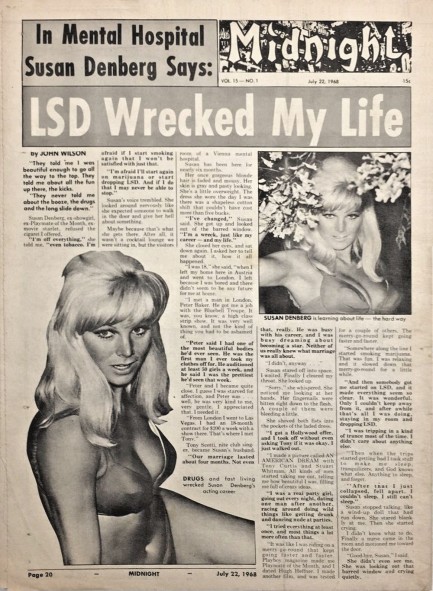
We've featured the Canadian tabloid Midnight numerous times. This one appeared on newsstands today in 1968. On the cover readers get a headline referring to Robert F. Kennedy, who had been assassinated the previous month. His name is accompanied by a prediction that his killer, Jordanian nationalist Sirhan Sirhan, would in turn be assassinated. It wasn't an outrageous prediction—during the late 1960s newsworthy figures were being dropped like three foot putts. Sirhan was never murdered, though, and he's still around today, languishing at Richard J. Donovan Correctional Facility in San Diego County, California.
Sirhan is an interesting character, but it's the story on Susan Denberg we're interested in today. Denberg, née Dietlinde Zechner, is a German born beauty who became a Playboy Playmate of the Year and screen actress, was a desired Hollywood party girl who, 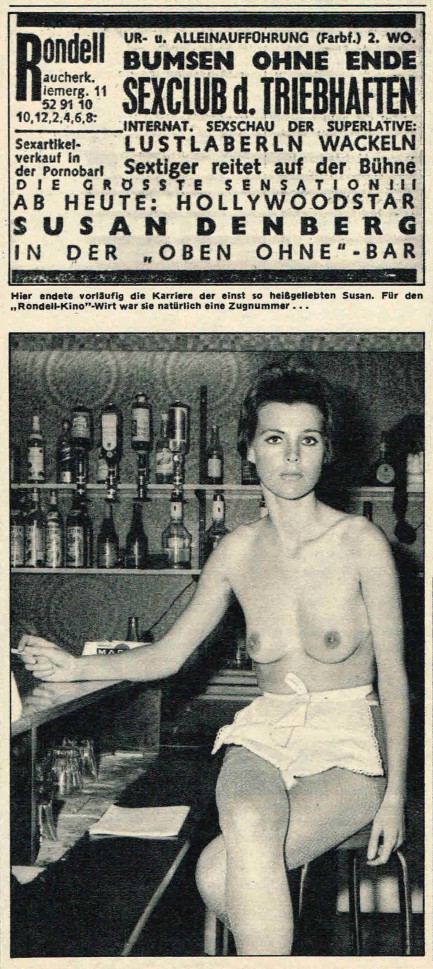 acording to sources, had relationships with Hugh Hefner and Jim Brown. She was generally regarded as one of the major sex symbols of her time, but she also became a drug addict. After making the 1968 film Frankenstein Created Woman Denberg returned to Europe and shunned the movie business. In fact, she kept such a low profile that for years sources incorrectly reported that she had died. acording to sources, had relationships with Hugh Hefner and Jim Brown. She was generally regarded as one of the major sex symbols of her time, but she also became a drug addict. After making the 1968 film Frankenstein Created Woman Denberg returned to Europe and shunned the movie business. In fact, she kept such a low profile that for years sources incorrectly reported that she had died.
Midnight journo John Wilson claims to have visited Denberg in a Vienna mental hospital near the beginning of her self-imposed exile, and his article is basically a recounting of his chat with her. He describes her depressing surroundings and portrays her as a sort of broken bird, quoting her as saying, “I was a real party girl, going out every night, dating one man after another, running around doing wild things like getting drunk and dancing nude at parties. And then someone got me started on LSD and it made everything seem so clear. It was wonderful. Only I couldn't keep away from it, and after a while that was all I was doing, staying in my room and dropping LSD.”
In 1971 Denberg had a child, and by 1972 was making her living on the nudie bar circuit, working as a topless server at the adult cinema Rondell in Vienna, and later dancing fully nude at another Vienna nightspot called Renz. She also worked elsewhere in Europe, including Geneva, where in 1974 she tried to commit suicide by swallowing a reported 200 sleeping pills, an amount that surely would have been fatal had she not been quickly found and sped to a hospital. In 1976 she became a mother again and retired from nude dancing. Today she lives quietly in Vienna.
Denberg's story is filled with twists and turns, and yet it isn't unique in a place like Hollywood. As she makes clear, once enough power brokers, modeling agents, and studio types tell a woman she's special she's probably going to believe them, but once she believes them it's hard for her to keep her head on straight. She sums up her journey to Midnight, “They told me I was beautiful enough to go all the way to the top. They told me about all the fun up there, the kicks. They never told me about the booze and the drugs, the long slide down.” 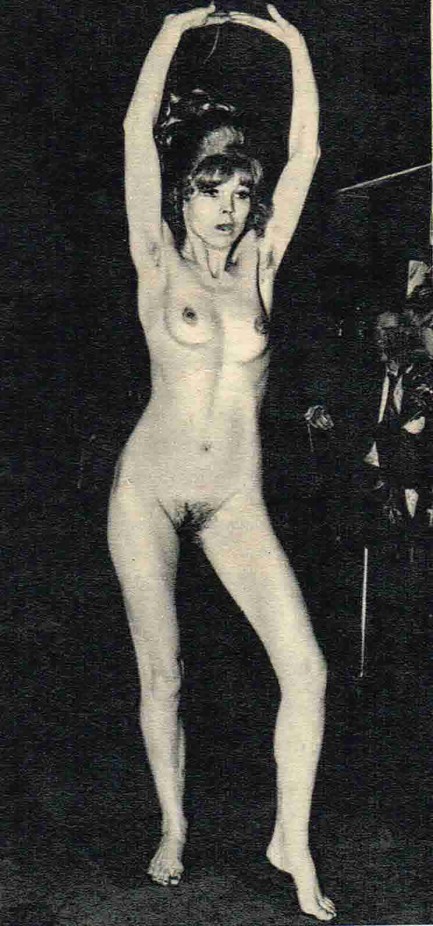 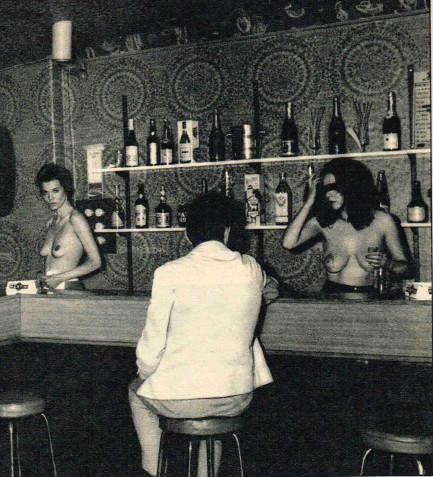
 I want the cash, the jewelry, and the licensing fees or I'll blow your brains out. 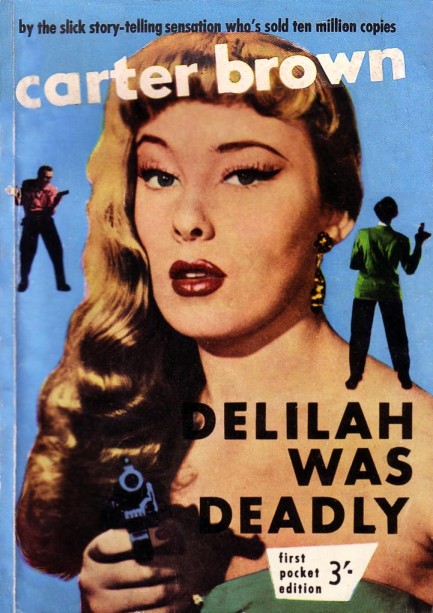 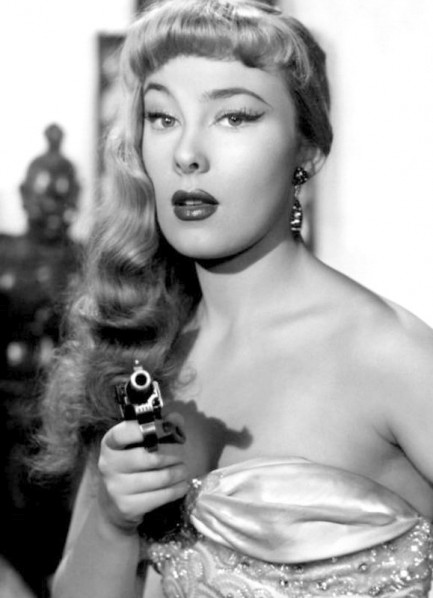
We're back to charting Horwitz Publications' unlicensed usage of celebrity images for its paperback covers. We've already talked about Joan Collins, Senta Berger, Elke Sommer, Lili St. Cyr, and others. This time the company borrows Belgian actress Dominique Wilms. The image chosen was originally used as a promo photo and the basis of the promo poster for her 1953 film debut La môme vert de gris, aka Poison Ivy. We're convinced now that Horwitz, which was based in Australia, did this because copyright agreements were lax or nonexistent regarding image licensing across international borders. And even if some rules were on the books, it's very possible Wilms and her management never saw the above cover, and if they did decided it wasn't worth a legal fight. The Horwitz guys were sneaky bastards. But as we've asked before, why bother? Wilms was so obscure at this point that Horwitz gained nothing from using her face. Don't get us wrong—she has a great face (and everything else too). But Horwitz could have simply used local models and produced identical results. That's the part we'll never get. But we've queried an expert about stolen paperback imagery and we'll share his answer soon. Note: Very soon. See here.
 The Lake is lovely, dark, and mysterious. 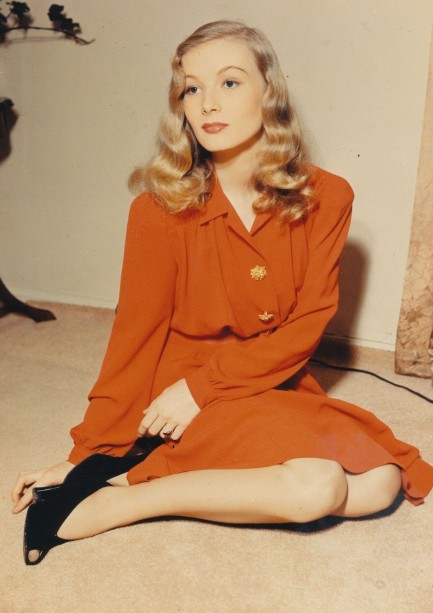
She was born Constance Frances Marie Ockelman but became known to the world as Veronica Lake. She played dozens of movie characters built around her screen trademark of low key coolness, but in real life she indulged in too much drink and drugs, was arrested several times for public drunkenness and disorderly conduct, and suffered through three failed marriages. Eventually she died of complications from cirrhosis of the liver. This photo shows her in classic, illusory mode—beautiful and just a bit detached—around 1945.
 Now I'll show you what we oilmen call directional drilling. 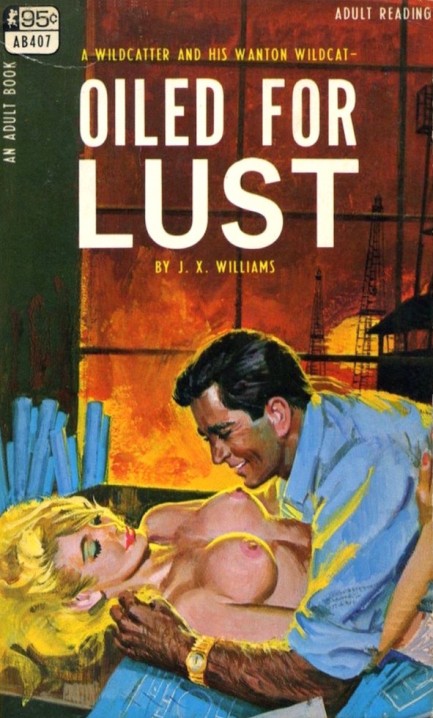
We always have to circle back to Greenleaf Classics because their covers are so brazenly funny. Oiled for Lust appeared in 1967 with the pseudonymous J.X. Williams credited as author. Many writers used the Williams name, but in this case even the Greenleaf Classics website is stumped as to who the author really was. Slide this into the unknown bin for now.
 On a clear day you can... *cough* *cough* 
You know we're all about vintage photos, especially of Los Angeles. This shot was made there in 1951 from the 32 story tower of City Hall and shows... well, not very much because of the smog. The first time a smog bank like this rose up in L.A., in 1943, residents panicked because they thought the Japanese had unleashed a gas attack. By the 1950s it was a regular occurrence. Smog in in the City of Angels has improved vastly since then, but living there still means inhaling the equivalent of about 180 cigarettes a year. The most complete global pollution study ever conducted was published by the World Health Organization last year. The result? Scientists learned that air pollution kills seven million people a year—more than AIDS, more than malaria, more than warfare. We have a few more shots from around the same time period below. 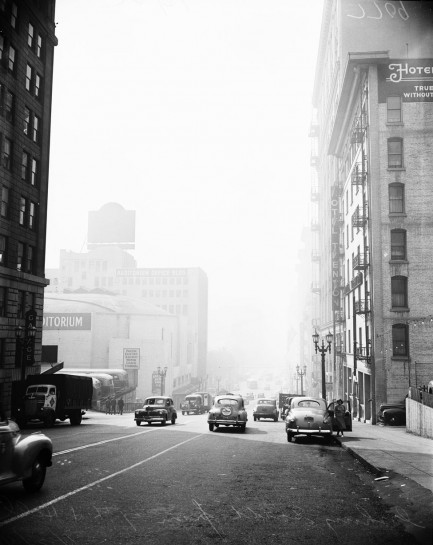 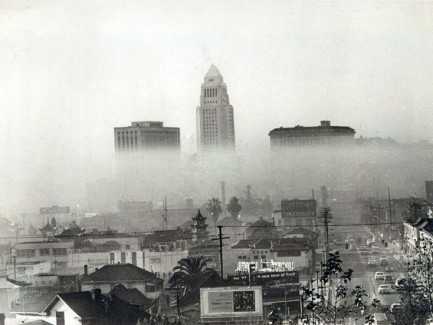 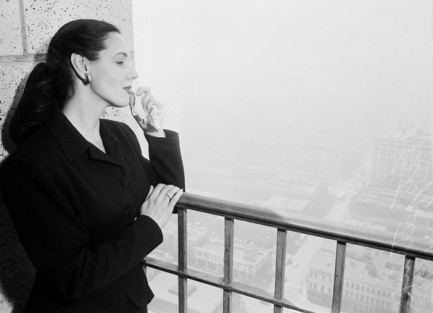 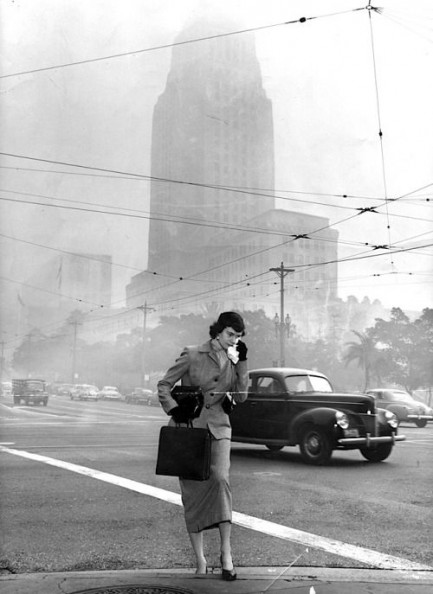
 What would you do to get your hands on $3.5 million? 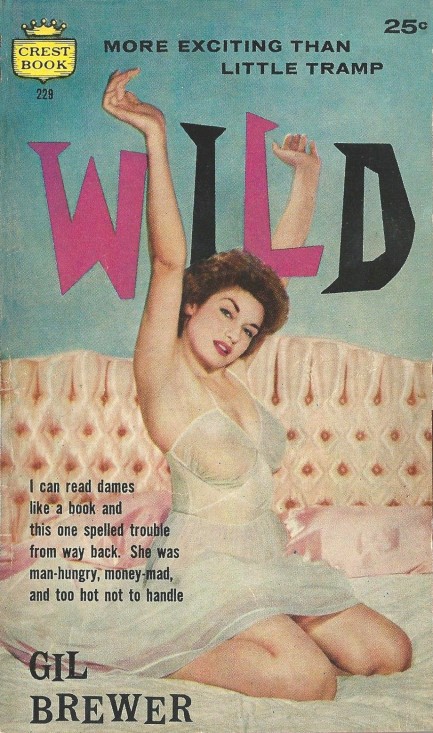 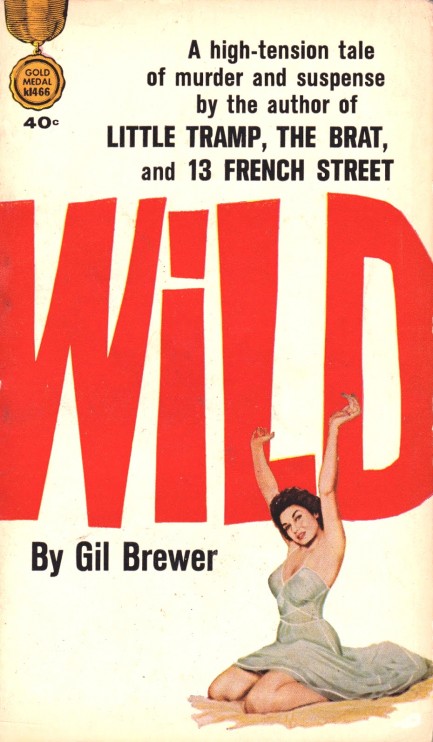
Gil Brewer wrote a lot of books. Wild rates in the bottom tier, according to most critics. When private detective Lee Baron takes over his father's investigative agency his first case is an old flame asking him to intercede on her behalf with her angry, cuckolded husband. Baron finds not an angry spouse but a mutilated corpse. Arms removed, face chopped apart with a hatchet, it's clear somebody was very angry at him. Or they were trying to obscure his identity—which means the corpse might not be the husband at all. When Baron uncovers a connection to a $400,000 bank robbery ($3.5 million in today's money) he begins to think he's landed a case that can put his agency on the map—if the police don't shut him down before he gets started. We agree this isn't Brewer's best, but it's still a mildly entertaining jaunt into Tampa, Florida's underbelly circa 1958. Above are two editions from Fawcett Crest and Gold Medal (aka Fawcett Crest).
 Reiko Ike leaves everyone's tongues tied in nots. 
Yes, we just shared a rare calendar page of pinku legend Reiko Ike, but what are you gonna do when she stars in photos like this one? We can't not post it. That's a double negative, we know, but some thoughts can only be expressed that way. We can't not not share this photo, because that would be immoral. Is that even right? Not the immoral part. The not part. If you decide you're not not not not going to do something, that means you're going to do it, right? Or maybe you can only successfully use a single double negative, and all the extra nots can only be used as emphasis rather than meaning, like saying you're never never never never going to do something, in which case that would mean you're not going to do it. Tricky questions. We could avoid them by using a single positive, but that would lack the exactness of the double negative. We will post it lacks the punch of we can't not post it. The meaning is similar, but the double negative removes our control over the decision, which is useful when the Pulp Intl. girlfriends look at the site. Baby, we couldn't not post it. So the double negative is better than the single positive and there's no such thing as a double positive. Well, maybe that's not strictly true. For instance, we're double positive about posting this photo. And gramatically speaking, people do say yes yes under certain circumstances, but those circumstances shouldn't occur while looking at naked photos on a computer. If that happens, we can only suggest that it's time to ask someone on a date.
 |  |
|
 |

The headlines that mattered yesteryear.
1916—Rockwell's First Post Cover Appears
The Saturday Evening Post publishes Norman Rockwell's painting "Boy with Baby Carriage", marking the first time his work appears on the cover of that magazine. Rockwell would go to paint many covers for the Post, becoming indelibly linked with the publication. During his long career Rockwell would eventually paint more than four thousand pieces, the vast majority of which are not on public display due to private ownership and destruction by fire. 1962—Marilyn Monroe Sings to John F. Kennedy
A birthday salute to U.S. President John F. Kennedy takes place at Madison Square Garden, in New York City. The highlight is Marilyn Monroe's breathy rendition of "Happy Birthday," which does more to fuel speculation that the two were sexually involved than any actual evidence. 1926—Aimee Semple McPherson Disappears
In the U.S., Canadian born evangelist Aimee Semple McPherson disappears from Venice Beach, California in the middle of the afternoon. She is initially thought to have drowned, but on June 23, McPherson stumbles out of the desert in Agua Prieta, a Mexican town across the border from Douglas, Arizona, claiming to have been kidnapped, drugged, tortured and held for ransom in a shack by two people named Steve and Mexicali Rose. However, it soon becomes clear that McPherson's tale is fabricated, though to this day the reasons behind it remain unknown. 1964—Mods and Rockers Jailed After Riots
In Britain, scores of youths are jailed following a weekend of violent clashes between gangs of Mods and Rockers in Brighton and other south coast resorts. Mods listened to ska music and The Who, wore suits and rode Italian scooters, while Rockers listened to Elvis and Gene Vincent, and rode motorcycles. These differences triggered the violence.
|

|
|

It's easy. We have an uploader that makes it a snap. Use it to submit your art, text, header, and subhead. Your post can be funny, serious, or anything in between, as long as it's vintage pulp. You'll get a byline and experience the fleeting pride of free authorship. We'll edit your post for typos, but the rest is up to you. Click here to give us your best shot.

|
|








 acording to sources, had relationships with Hugh Hefner and Jim Brown. She was generally regarded as one of the major sex symbols of her time, but she also became a drug addict. After making the 1968 film Frankenstein Created Woman Denberg returned to Europe and shunned the movie business. In fact, she kept such a low profile that for years sources incorrectly reported that she had died.
acording to sources, had relationships with Hugh Hefner and Jim Brown. She was generally regarded as one of the major sex symbols of her time, but she also became a drug addict. After making the 1968 film Frankenstein Created Woman Denberg returned to Europe and shunned the movie business. In fact, she kept such a low profile that for years sources incorrectly reported that she had died.















